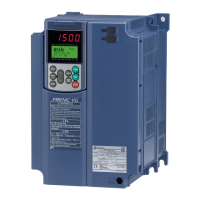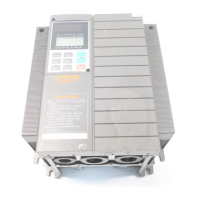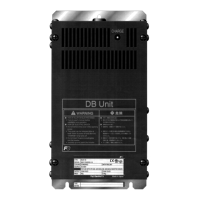5.3 Description of Function Codes
5-56
■ Pulse scaling factor 1 (d62), pulse scaling factor 2 (d63)
For pulse train input, set the relationship between input pulse frequency and frequency setting value by function
code d62 (Command (pulse train input) pulse scaling factor 1) and d63 (command (pulse train input) pulse scaling
factor 2).
Figure 5.3-2 Relationship between input pulse frequency and frequency setting value
As shown in the figure above, set input pulse frequency [kp/s] to function code d62 (command (pulse train input)
pulse scaling factor 1) and set frequency setting value [Hz] (when the input pulse frequency becomes the value set
to function code d62) to function code d63 (command (pulse train input) pulse scaling factor 2). At this time, the
relationship formula of input pulse frequency to be entered and frequency setting value f
*
(or speed command
value) is as follows:
f
*
[Hz] = Np [kp/s] ×
Pulse scaling factor 2 (d63)
Pulse scaling factor 1 (d62)
f* [Hz]: Frequency setting value
Np [kp/s]: Input pulse frequency to be input
Depending on the pulse train sign, polarity of the command is determined. Rotation direction of the motor is
determined by the polarity of pulse train input and “FWD”/”REV” command. The relationship between the pulse
train input polarity and rotation direction is specified in Table 5.3-1.
Table 5.3-1 The relationship between the pulse train input polarity and rotation direction
Polarity according to the pulse train input
Run command Rotational direction
+ “FWD” (Forward rotation command) Forward rotation
+ “REV” (Reverse rotation command) Reverse rotation
- “FWD” (Forward rotation command) Reverse rotation
- “REV” (Reverse rotation command) Forward rotation
■ Filter time constant (d61)
Set filter time constant for pulse train input. The larger the time constant, the slower the response. Specify the
proper filter time constant by taking into account the response speed of the machine. If the pulse is lower and
frequency command fluctuates, set larger time constant.
■ Switching frequency setting
Switch frequency setting 1 (F01) and frequency setting 2 (C30) by the signal “Frequency setting 2/frequency
setting 1” “Hz2/ Hz1”, which was assigned to the external digital input terminal.
(Refer to Function code E01 to E05 (Data =11) to find the details of “Hz2/ Hz1”.
Input signal “Hz2/ Hz1” Frequency setting method to be selected
OFF Frequency setting 1 (F01)
ON Frequency setting 2 (C30)

